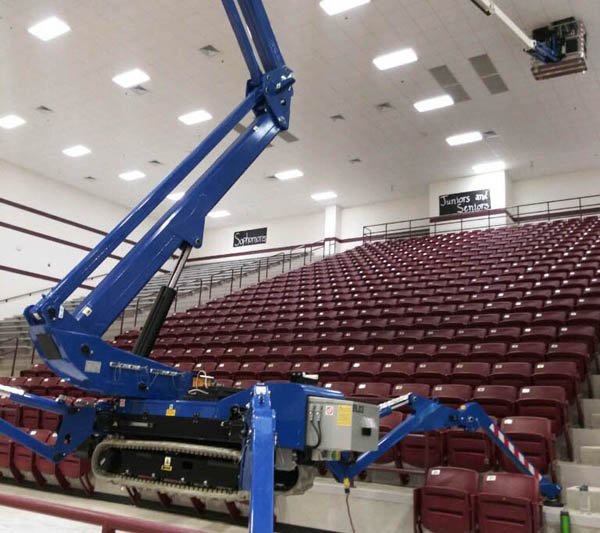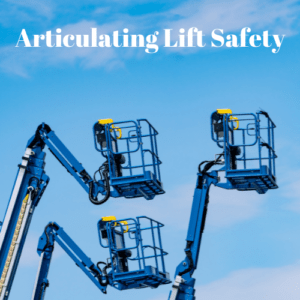Understanding the efficient and safe use of articulating lifts is important for getting the most out of their capabilities. This includes the many special safety features that are incorporated in these engineering marvels.
The unique and distinctive shape of articulating lifts provides special usability and access to challenging high work areas f for these specialized man lifts.
Articulating lifts are constructed with multiple pivot points (called knuckles, joints, or jibs) that provide an extensive range of motion and extended reach. This design feature allows for “up and over work” where space is limited. While all lifts with have multiple pivot points are classified as articulating lifts, they are designed for different and specialized tasks.
Let’s take a closer look at the primary types of articulating lifts.
Articulating Boom Lifts
Articulated boom lifts have long, extendable arms that reach as much as a hundred-and-forty foot. It’s common for these lifts to allow a 360-degree to 400-degree non-stop or non-continuous rotation with zero tail swing.
Often known simply as articulating booms, lifts within this class are available in two basic types: standard and telescopic.
Standard articulating booms feature two or more hinged boom sections. These features give these lifts the nickname “knuckle booms” for their ability to put an operator over and around obstacles. They are famous among utility companies for tasks that must allow service technicians to navigate power lines, trees, and similar obstacles.
Telescopic booms offer the same horizontal access as other aerial lifts. However, it has an added feature. Like a telescope, the boom itself is normally designed without the ”knuckles” of the articulating model. This limits the ability to accommodate tasks where awkward positioning is needed. However, for heights, nothing beats a telescopic boom and it is the popular choice for such jobs..
Where are Articulated Boom Lifts Commonly Used?
Articulated boom lifts offer secure work access to the sides of buildings or aircraft, the pinnacle of trees, and the indoor heights of structures such as a cathedral. In fact, the
articulating lift can maneuver over rafters, sound system, and an almost limitless number of other unreachable places.
Also designed for heavy-duty applications, many articulating and telescopic booms are engineered with a rear axle hydraulic differential lock. This design provides balance on tough and uneven terrain. You’ll find many of these lifts are equipped with four-wheel drive capabilities available for added power and maneuverability.
For other specialized tasks, you will find a variety of boom lifts designed to fit into tight work areas, such as doorways, slim alleys, and narrow passageways. Some models are only four feet wide, allowing them to be easily rolled through narrow aisles and require minimal storage space.
Articulating Spider Lifts/Atrium Lifts
Often called “spider lifts” because of their unique outriggers, these articulating lifts are also commonly referred to as atrium lifts or articulating man lifts. They have special capabilities beyond those of standard boom lifts. Their smaller size is an advantage to accessing many interior spaces. Their design provides a core body that supports the lift. The four legs, or outriggers, provide solid support when the lift is extended to its maximum height and reach. This specialty engineering provides spider lifts and atrium lifts with many advantages:
• Extreme Height and Reach. The multiple hinges in its arm provide flexibility for working its way around obstacles. Articulating atrium lift arms also incorporate a telescoping capability that can extend up to 100 feet or more, depending on the specific model. The horizontal reach of up to 45 feet makes this articulating lift indispensable for many tasks. These amazing capabilities are possible due to the outrigger design, which also allows flexibility in placing the lift.
• Self-Powered Mobility. Spider or Atrium lifts have their own engines that run on fuel, electricity, or batteries. This means they are easily moved to and operated in difficult-to-access spots..
• Light Weight. A standard boom lift requires towing or a heavy-duty method of transportation. On the other hand, Spider lifts are easier to handle because of their engines and the lightweight and compact design and construction.
• Versatile. Spider and atrium lifts use electricity or battery power, enabling operation inside buildings or in areas where gas fumes and exhaust are prohibited. However, many spider lifts also have a fuel-operation mode, allowing them to be used in outside applications.
• Compact. The unique function of the outriggers allows spider lifts to be “collapsed” to a package of as little as 30 inches wide and 6 feet tall. This provides easy transportation with trailers and convenient storage.
• Work Platform Capacity. Depending on the model, articulating lifts have a work basket carrying capacity from 176 to 500 pounds. This allows up to two workers access to the work area with their tools and equipment.
• Track-Driven. The most popular atrium and spider lifts are track-driven. This important feature allows them to operate on steeper terrain and provides more protection for interior floor spaces.


